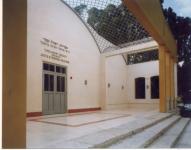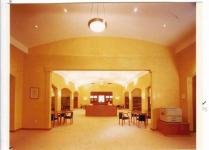OHEL SHEM COMMUNITY AND SCHOOL LIBRARY , Israel
At the opening ceremony of the library the mayor said: “This library, one of the most dignified in the country, will be a cornerstone and a contribution to the education and preparation of the young generation for the future. It will teach the young that spiritual and moral values are of essence and should be their guiding light.”
It seemed to me that beyond its value as a resource center, the creation of an aesthetic learning environment that can be experienced by the students in the library will be an educational and cultural value in itself. It will prepare them to regard aesthetics and awareness to the quality of the built environment as guiding values in their life. The spiritual experience and the pleasant ambience I wanted to create for the reader was deeply rooted in the physical structure and the spatial order of the building.
The building itself was situated between two rows of old fichus trees, which dictated the building’s overall plan.
A wide entrance stairway leads to the entrance balcony, where students can “hang out” if they choose. The shaded balcony and the stairway serve as a transition area, which both connects and separates the building and the school’s main walkway.
The color chosen for the exterior walls was the hue of the golden leaves that fall outside the building in the autumn, a process which is illustrated in detail in the first chapter of the book. Yellow pigments were mixed with the plaster, creating a perfect harmony with the greenness of the trees and the blue sky.
The interior of the building consists of a sequence of spaces that lead one into another; all visually connected. The entrance hall is a transition area, designated to slow the pace and lower the voice of those entering the library, providing space for the lockers.
The entrance room opens to an open space forming a transition area leading to the reading hall. In here are the catalogues, the copy machines and the display alcove for the new books.
The librarian’s counter is placed at a central position in the main reading room. That area is clearly marked by a seven-meter-high arched ceiling. The reading areas at both sides of the main room are built as alcoves that are openly related to the central space, each one dedicated to a specific subject.
In contrast to contemporary libraries, where there is a clear separation between the sitting area and the bookshelves, here the bookshelves embrace the readers, forming an intimate relationship between the reader and the books. Each window at the center of the reading alcoves was aligned with the position of the trees.
All the interior walls and ceilings are coated with a marble textured Venician stucco, creating an ambience of warm yellow on the walls and of pure white on the ceilings.
The design of the furniture, the light fixtures and the choice of colors all constituted an integral part of the design process, and contributed to the pleasant and unique atmosphere experienced by the readers.
The reading room opens to the music and periodicals section. Here the students can lean back in soft armchairs, read magazines or listen to music by earphones. At the far end, entered through glazed doors, is the computer and multimedia room. The different heights of the ceilings in the various rooms create diverse atmospheres directly related to the range of activities.
For more details please see:
http://www.niliportugali.com/public_buildings_OHEL%20%20SHEM.html
For more details see Portugali`s New Book:
The Act of Creation and the Spirit of a Place
A Holistic-Phenomenological Approach to Architecture
/ Nili Portugali
Edition Axel Menges, Stuttgart / London 2006
Favorited 1 times


